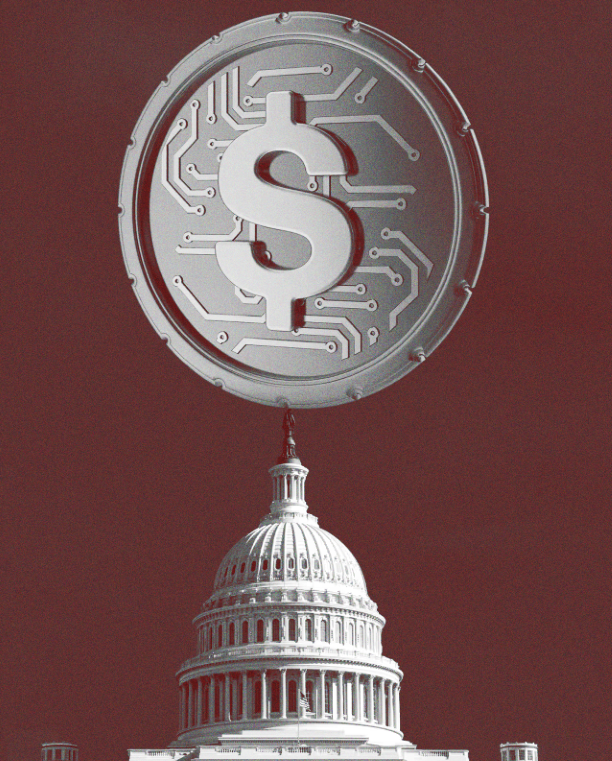Yesterday, Congress passed the “Guiding and Establishing National Innovation for U.S. Stablecoins Act,” or GENIUS for short, teeing up the first major federal crypto legislation in the United States. President Trump will sign the bill today. Below, we break down what stablecoins are, the contents of the GENIUS Act, and its impacts.
What is a stablecoin?
A stablecoin is a digital currency that is pegged to the value of another asset. Most are pegged to the U.S. dollar, while some follow other fiat currencies or commodities. They serve individuals and institutions who want currency on the blockchain (as opposed to off-chain in a standard bank account) so they can transact on crypto exchanges, convert funds into other digital currencies, or use funds outside the traditional financial system.
One of stablecoins’ key advantages is stability, as their name suggests. By remaining pegged to the US dollar, they take advantage of the dollar’s general stability while operating on the blockchain. Cryptocurrencies are often very volatile, which poses a risk to businesses and individuals who transact in them. Over the last year, Bitcoin has fluctuated ~200% in value, while Tether (the largest stablecoin issuer) has moved ~2%. Stable is as stable does.
Common use cases for stablecoins include:
- B2B transactions. When a customer swipes a credit card, interchange fees from issuing banks, acquiring banks, and card networks total between 1.5-3.5% of the transaction (here’s a breakdown of how this works). Stablecoin fees are generally flat rather than percentage-based and therefore lower for many transactions.
- International transfers. Using a traditional remittance provider like Western Union costs 4.8% on average, whereas a stablecoin would only cost 0-1%.
Money-laundering and avoiding sanctions. Stablecoins are also used for more nefarious purposes. 66% of all illicit traffic on the blockchain is in stablecoins, according to Chainalysis. Russia and Iran have both been exposed as using stablecoins to flout sanctions and move money illegally. The GENIUS Act proposes stronger controls in this area.
What’s in this legislation?
- A regulatory framework for stablecoins. Certain banks and corporations can now legally issue stablecoins, redeem them as payment, manage reserves, and provide custodial services. Read more on the criteria for what types of entities can issue stablecoins and the role of states in the framework here.
- Reserve assets and transparency. Stablecoin issuers have to maintain a one-to-one reserve to all outstanding coins in short-term treasuries. They also must publish monthly disclosures on the number of stablecoins in circulation compared to reserves. Any issuers over $50 billion market cap must be audited annually.
- Stronger anti-money laundering (AML) and terrorism controls. All stablecoin issuers must have AML and sanctions programs, suspicious activity reporting requirements, and a customer identification system, in addition to the the ability to block and freeze transactions if faced with a “lawful order”.
- Issuers must prioritize coin holders in a bankruptcy. Holders of a coin have claims to the reserve assets, the same way money market funds are protected. This is in part a reaction to high-profile stablecoin blowups like Terra and Iron Finance and consumer protection concerns related to FTX.
- Restrictions on non-finance companies issuing stablecoins. Any public company that isn’t predominantly financial (banking, payments, retail) may not issue a stablecoin without approval from the new Stablecoin Certification Review Committee, which consists of the chair of the FDIC, chair of the Federal Reserve Board, and the Secretary of the Treasury. This is widely viewed as a check on Big Tech’s ability to drive stablecoin adoption.
Why is this important?
- Potentially cut out the credit card networks. Today, Visa and Mastercard charge 2-3% per transaction. If big merchants like Walmart and Amazon launch their own stablecoins for customers to use, they could save billions in fees and settle sales much more quickly.
- Faster settlements than bank transfers. Traditional bank transfers rely on intermediaries systems like ACH, Fedwire, SEPA, and SWIFT that have business hours and batch transactions. Blockchains operate 24/7/365; no downtime on bank holidays or weekends. Most transactions clear in seconds. For instance, JPMorgan is launching a stablecoin-adjacent product called JPMD for their institutional clients only, as a way to give them a way to move money around more quickly while still staying attached to the traditional banking system.
- Cross-border transactions will get easier. Stablecoins are borderless by default, so neither party has to have a correspondent bank or convert currency. Users can transact in a currency that is in essence dollar-denominated even if access to dollars is constrained by compliance, regulations, and local capital controls. No wire fees or wide spreads exchanging currency. Blockchain fees are generally much lower.
- Reserve yields = $$$. The GENIUS Act will require stablecoin issuers to hold assets in reserve for every digital asset they issue, which both protects users while codifying the business model for issuers. For instance: a user gives JPMorgan $1, and it mints one stablecoin. That $1 goes into the reserve of short-term treasuries. If the user wants their dollar back, JPMorgan “burns” the stablecoin, destroying it forever, and returns the dollar. In the meantime, JPMorgan makes a few percentage points just for holding the reserves and issuing the coin. At scale, this can add up to a huge amount of revenue.
Taking a step back, this bill is a big win for the crypto industry, which has very publicly and effectively flexed its muscles in Washington. The GENIUS Act isn’t just a regulatory framework, it’s the federal government planting a flag in the stablecoin frontier. The rules of the road are being written for what could become a foundational layer of financial infrastructure. Whether this creates a more open, efficient financial system or simply shifts control from Silicon Valley to Wall Street remains to be seen. What’s clear is this: stablecoins are going mainstream.









